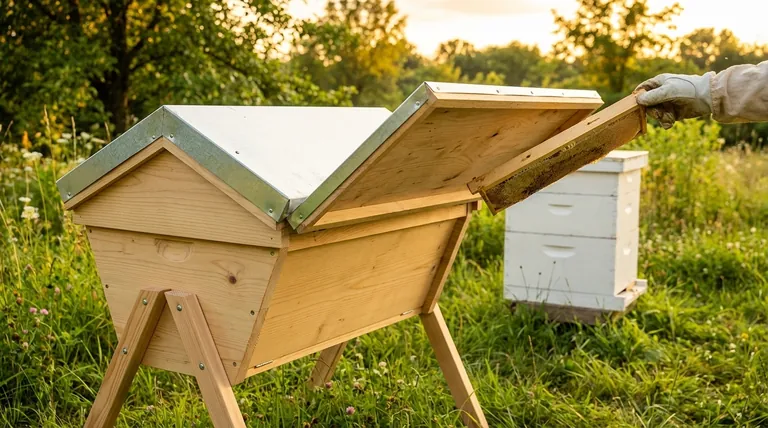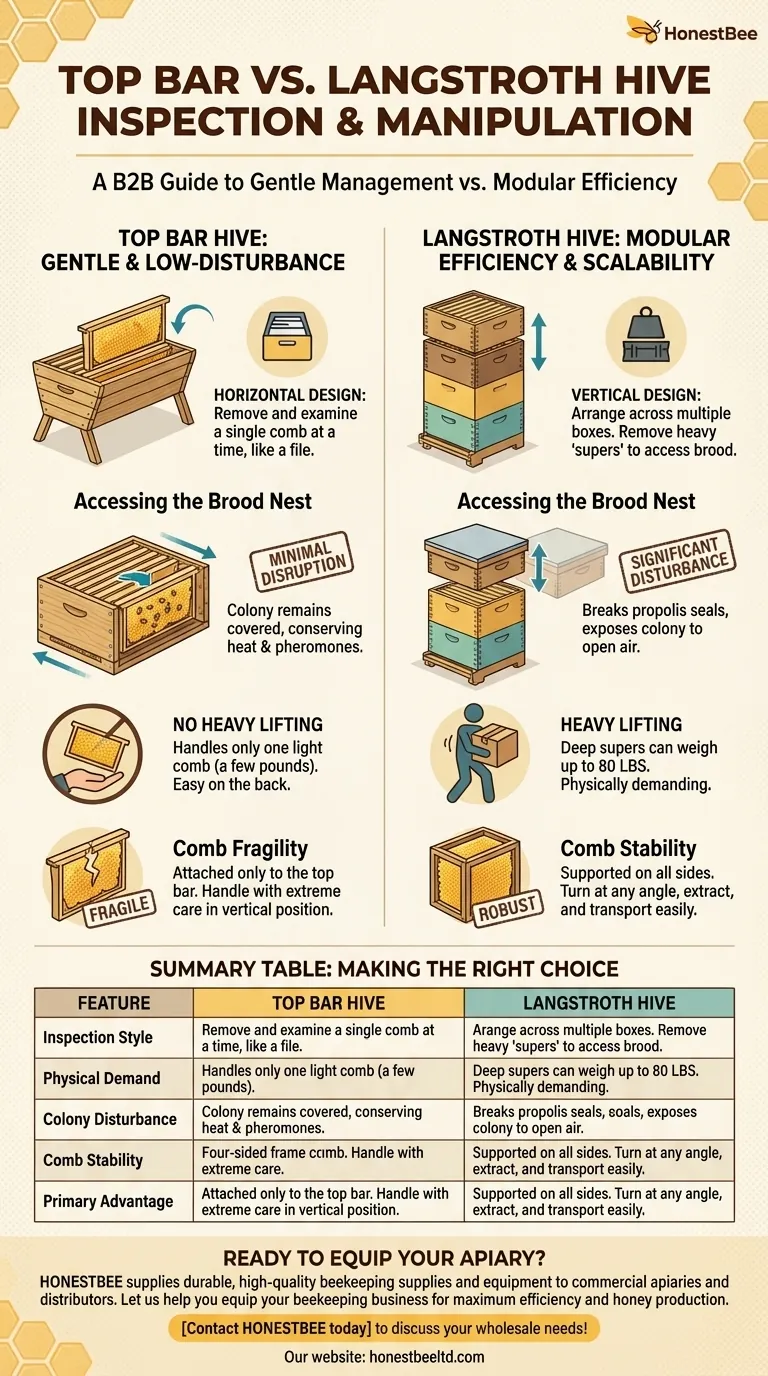From a management perspective, a top bar hive offers a less invasive and less physically demanding inspection process compared to a standard Langstroth hive. Its horizontal design allows you to remove and examine a single comb at a time, leaving the rest of the colony undisturbed. This approach minimizes disruption, keeps the bees calmer, and completely avoids the need to lift heavy boxes filled with honey.
The core difference in hive management comes down to a trade-off: Top bar hives are designed for gentle, low-disturbance inspections that are easy on the beekeeper's back. Langstroth hives are engineered for modular efficiency, scalability, and maximum honey production.

The Inspection Process: Horizontal vs. Vertical
Accessing the Brood Nest
In a top bar hive (TBH), the entire colony is contained within one long, horizontal box. To inspect the brood nest, you simply slide the other bars to the side and gently lift out one comb, much like pulling a single file from a filing cabinet.
In a Langstroth hive, the colony is arranged vertically across multiple boxes. The brood nest is typically in the bottom box or two. To access it, you must first remove any upper boxes (called "supers"), which are often heavy with honey.
Minimizing Colony Disturbance
The single-comb inspection method of a top bar hive is far less disruptive. The rest of the colony remains covered and contained, which helps conserve heat and keeps the bees' alarm pheromones from spreading throughout the hive.
By contrast, separating the boxes of a Langstroth hive breaks the propolis seals and exposes a large portion of the colony to the open air. This is a more significant disturbance that can agitate the bees and requires more time for them to repair and reorganize.
Physical Demands and Beekeeper Ergonomics
The End of Heavy Lifting
A key advantage of the top bar hive is the elimination of heavy lifting. The only weight you handle is that of a single comb, which is typically just a few pounds.
A deep Langstroth super full of honey can weigh up to 80 pounds, and even medium supers can be 40-50 pounds. This can be a significant physical barrier for many beekeepers.
Langstroth Modularity
While Langstroth boxes are heavy, their modularity is a core strength. You can easily add or remove boxes to give the bees more or less space as the season progresses. This allows for rapid expansion and efficient management.
Understanding the Trade-offs: Stability vs. Gentleness
The Fragility of Top Bar Combs
The primary manipulation disadvantage of a top bar hive is comb fragility. The comb is only attached to the wooden top bar and hangs freely. It must be handled with extreme care and always kept in a vertical position. If tilted horizontally, a new, heavy comb can easily break off the bar.
The Robustness of Langstroth Frames
Langstroth hives use four-sided frames that provide support for the comb on all sides. This makes the comb incredibly stable and durable. You can turn frames at any angle for inspection, transport them easily, and even extract honey from them in a centrifuge without destroying the comb.
Equipment and Standardization
The Langstroth hive is the de facto industry standard. Equipment, replacement parts, and educational resources are abundant and affordable.
Top bar hives are less common, and while plans are widely available, finding ready-made equipment or compatible accessories can be more challenging and expensive.
Making the Right Choice for Your Goal
Your ideal hive depends entirely on your beekeeping philosophy and physical capabilities.
- If your primary focus is a gentle, natural approach and you want to avoid heavy lifting: The top bar hive is the superior choice for its less invasive and physically manageable inspection process.
- If your primary focus is maximizing honey production, using standardized equipment, or managing many hives: The Langstroth hive is the industry standard for its proven efficiency, scalability, and widespread support.
- If you value robust combs that are easy to handle, extract, or transport: The four-sided frames of a Langstroth hive offer significantly more structural integrity and management flexibility.
Ultimately, your decision reflects whether you prioritize a less physically demanding beekeeping experience or the proven efficiency of a modular system.
Summary Table:
| Feature | Top Bar Hive | Langstroth Hive |
|---|---|---|
| Inspection Style | Single-comb, horizontal | Multi-box, vertical |
| Physical Demand | Low (no heavy lifting) | High (heavy supers) |
| Colony Disturbance | Minimal | Significant |
| Comb Stability | Fragile (attached to one bar) | Robust (supported by a frame) |
| Primary Advantage | Gentle, back-friendly management | Scalability and high honey production |
Ready to choose the right hive for your apiary?
Whether you manage a commercial operation or distribute equipment, the right tools are essential for success. HONESTBEE supplies durable, high-quality beekeeping supplies and equipment to commercial apiaries and distributors through our wholesale-focused operations.
Let us help you equip your beekeeping business for maximum efficiency and honey production.
Contact HONESTBEE today to discuss your wholesale needs!
Visual Guide

Related Products
- Long Langstroth Style Horizontal Top Bar Hive for Wholesale
- HONESTBEE Professional Multi-Functional Hive Tool with Ergonomic Wood Handle
- Langstroth Bee Hives Bee Keeping Box for Beginners Beekeeping
- HONESTBEE Professional Long Handled Hive Tool with Precision Cutting Blade
- HONESTBEE Advanced Ergonomic Stainless Steel Hive Tool for Beekeeping
People Also Ask
- What is a top bar bee hive? A Natural, Low-Stress Beekeeping Solution
- What are the box management requirements for a top bar hive vs. Langstroth? Choose Your Hive Strategy
- What are the main differences between Langstroth hives and top bar hives? Choose the Right Hive for Your Beekeeping Goals
- What are the most popular types of hives besides the Langstroth? Top Bar & Horizontal Hives Explained
- What are the benefits of a top bar hive? A Natural, Low-Impact Approach to Beekeeping



















